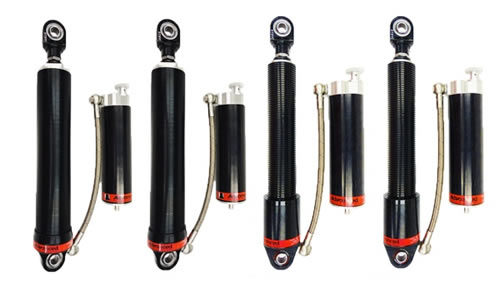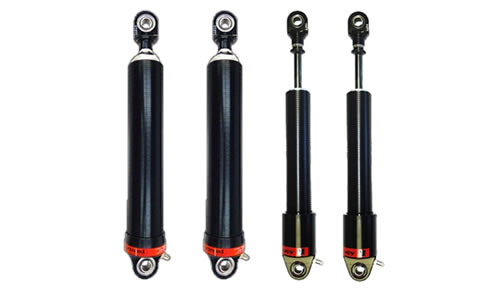Asphalt Late Models
Asphalt Late Model Newsletter
Valving Updates
Left Front
The current valving curve for the left front is a shock with less zero point and more midrange rebound. It has always been a fine balance in providing enough rebound to hold the nose of the chassis down throughout the corner but not too much that it skips across the bumps. This combination is achieved with a piston that is more linear on the rebound. This update can be done to any current left fronts or new shocks. The rebound requirement of this corner depends on several factors. When a stiffer left front bump stop or bump spring is used, less rebound is needed. Because if it does not compress too much, it will not have the energy to extend. A chassis with extra jacking force on the left front suspension requires less rebound on this corner. Some racing series check the chassis ride height when the car comes off the track. All these factors and more must be considered when choosing the rebound for the left front shock. The compression requirements depend on a few factors: track configuration, spring rate, and horsepower of the car. The current chassis requires a soft compression, so the chassis sets down on corner entry especially on lower horsepower cars where not much brake is applied. High bank tracks require additional L.F. compression to keep the chassis from diving and making the car tight on entry.
Right Front
The current valve curve for the right front shock is less zero point with a flat line piston and very little or no bleeds. The right front demands are different from the left front. The bump stops or bump spring package determines how much rebound is needed. If your chassis setup is dominant on the left front bump you will require less rebound in the R.F. shock than the left front shock. Rebound on the right front makes the front end more positive in the middle of the corner and on corner exit. Too much rebound in the right front will make the chassis free on corner exit. Increased compression on the right front shock tightens the chassis on corner entry to exit. Too soft on R.F. compression will free the chassis throughout the corner. If the right front compression is too soft, more spring is required to keep the chassis from being loose on corner entry.
Rear Shocks
The level of tuning the chassis balance with the rear shocks has increased in the last couple of years. Balancing the traction generated by the rear shocks and turning in the center of the corner is a fine balance. Many factors, such as the track surface, tire compound, spring package, suspension design, and more, determine how much rear traction is required by the rear shocks. It is important that you let us know this information to achieve this balance.
Left Rear
Increasing the rebound in the left rear shock will create more forward bite and free the chassis up on corner entry. Too much rebound in this shock will make the chassis loose on corner entry especially on older tires. Increased compression on the L.R. shock will free the chassis up on corner entry and make the chassis tighter on corner exit.
Right Rear
Increasing the rebound in the right rear shock has the same results as the left rear shock. Too much rebound in this shock will make the chassis tight in the middle of the corner and on corner exit especially with lower horsepower cars.
Softer compression on this shock will create more grip throughout the corner. Increased compression may be required on low horsepower cars to free up the chassis in the center of corner.
Right Rear Trailing Link
In the few racing series that still allow moveable trailing link, A.R.S. builds the best one. This unit allows you to extend your right-side wheelbase to roll the center of the corner. Then on corner exit, you can shorten the right side wheelbase up to ¾ inch. The internal dampening allows the spring to extend slowly on corner entry and not upset the chassis. If this is legal where you race, you need this in your car.
SHOCK DYNO TESTING SERVICE
Now that the racing season is over, this is the ideal time to start preparing for next season. Many of our customers send all their shocks in to be dynoed at this time of the year, so that they can be checked after a long season of racing. To encourage all our customers to assess their shocks’ condition before the next season, we’re offering a reduced cost for shock dyno services on any A.R.S. shock—only $10 per shock until January 31, 2025. This reduced shock dyno offer will give you a chance to evaluate the condition of your shocks after a season of racing and at the same time review any new valving combinations.
When sending your shocks to us for service, please enclose a note with return address, phone number, and a brief description of what you would like done to your shocks. A shock maintenance form is available from our website. After the shocks are dynoed, we can call you with the results and discuss the outcome of your shocks or any new shock combinations. Many customers send all their shocks to us during this special dyno offer, so send your shocks in as early as possible to avoid any delays in preparing for next season.
Shock Packages
Package 1- $3,200
($3,440 with four C/O Kits)
Fronts – 4000 Series Mono-Tube E-Model Double Adjustable
Rears – 3200 Series Mono-Tube E-Model Double Adjustable

Fronts
The 4000 Series shock is a large body mono-tube (gas) shock with a hard black anodized aluminum body and canister that is double adjustable. This shock uses CNC machined aluminum internal parts designed for racing with no aftermarket parts. These shocks contain the latest T/C valving for maximum front grip. They are E-Model Adjustable and include the new style adjusting wheels that allow the eyes to be removed easily to change bump stops. The Double Adjustable with the remote canister allows for substantial reduction in rod pressure which provides more grip. This shock allows the racer to adjust the rebound and compression dampening completely independently. This shock allows for the rebound to be adjusted at the eye of the shock and the compression to be adjusted on the remote canister of the shock. This shock has a Schrader valve that allows fine tuning of the gas pressure. This shock will eliminate the need for extra shock inventory by creating one shock for each corner of your car. The large body shock accepts 2 1/4” & 2 ½” I.D. or 5” O.D. Springs and is available in 5”, 6”, 7”, 8” & 9” shaft lengths
Rears
The 3200 Series shock is a small body mono-tube (gas) shock with a hard black anodized aluminum body and canister. This shock uses CNC machined aluminum internal parts designed for racing with no aftermarket parts. These shocks contain the latest T/C valving for maximum traction. They are E-Model Eye Adjustable. The base valve design in this shock allows for very low gas pressure to be used and still function properly. When combined with our canister option and the ability to run low rod pressure this shock has virtually no rod pressure build up and allows for maximum grip a driver can feel. This shock has a Schrader valve that will accept 10-100lbs. gas pressure which provides for fine tuning of the chassis balance. The small body shock accepts 1 7/8”, 2 ¼” & 2 ½” I.D. Spring & is available in 5”, 6”, 7”, 8” & 9” shaft lengths.
Package 2- $2,200
($2,440 with four C/O Kits)
Fronts – 4200 Series Mono-Tube E-Model Single (Rebound) Adjustable
Rears – 3200 Series Mono-Tube E-Model Single (Rebound) Adjustable

Fronts
The 4200 Series shock is a large body mono-tube (gas) shock with a hard black anodized aluminum body and canister if choosing that option. This shock uses CNC machined aluminum internal parts designed for racing with no aftermarket parts. These shocks contain the latest T/C valving with a large diameter flat line piston for maximum front grip. They are E-Model Eye Adjustable that include the new style adjusting wheels that allow the eyes to be removed easily to change bump stops. This shock utilizes a base valve that is installed between the floating piston and the valving piston to isolate the pressure, allowing for substantial reduction in rod pressure. These rebound adjustable shocks contain check valves to ensure no bleed-over when adjusting the rebound dampening. This shock has a Schrader valve that provides for fine tuning the gas pressure. This shock accepts 2 ½” I.D. or 5” O.D. Springs and is available in 5”, 6”, 7”, 8” & 9” shaft lengths.
Rears
The 3200 Series shock is a small body mono-tube (gas) shock with a hard black anodized aluminum body. This shock uses CNC machined aluminum internal parts designed for racing with no aftermarket parts. These shocks are rebound adjustable valved for maximum traction with the latest T/C valving. They are E-Model Eye Adjustable. The base valve design in this shock allows for very low gas pressure to be used and still function properly. This shock gives the driver more feel and allows the car to grip the track more. This shock has a Schrader valve that will accept 10-50lbs. gas pressure which provides for fine tuning the chassis balance. The small body shock accepts 1 7/8”, 2 ¼” & 2 ½” I.D. Spring & is available in 5”, 6”, 7”, 8” & 9” shaft lengths.
In addition to your shock package you may also want:
Gas Gauge 100 PSI (ARS #40887)
Coil-Over Kit (ARS #301045)
Coil-Over Kit (ARS #40101T)
(Any package can be customized for your specific needs, ask how when you call to order!)
